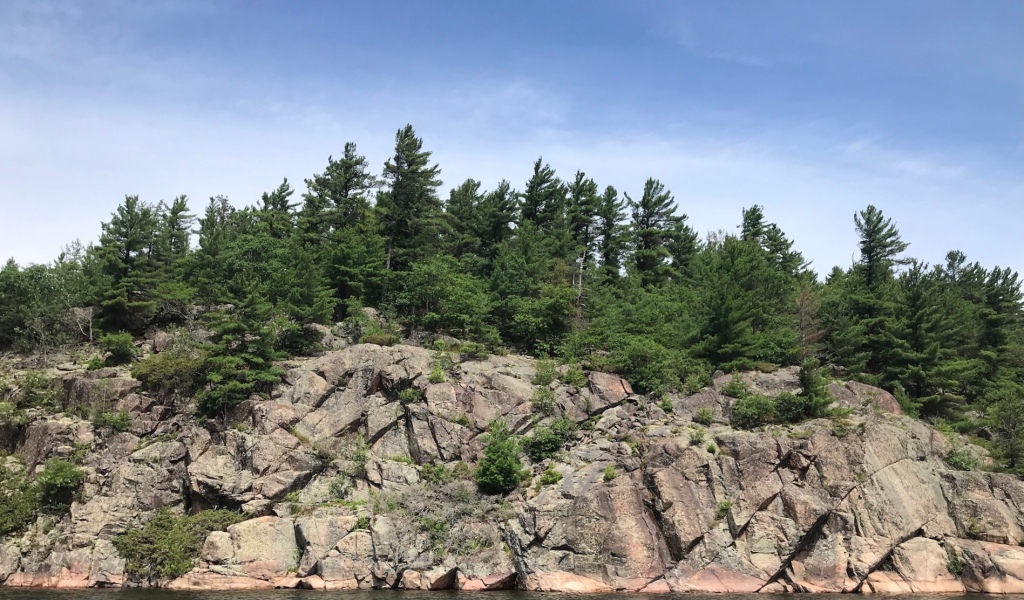“By the mark, twelve,” I report with a grin as the line in my hands stops feeding out just shy of the second mark. I’ve always wanted to say that. I’ve read about lead lines—literally a lead weight tied to a long piece of rope—but I never thought I’d get to use one.
I’m in the front of a rowboat, sounding the bottom as we creep into a tiny bay in the Bustard Islands before bringing Jack Tar in. Normally we would use Chris’s handheld fish finder to check the depth of uncharted water but we’re not on our boat, we’re on a friend’s sailboat, and John likes to do things the traditional way.
“By the deep, nine.”
Fortunately, Chris and I have both read Patrick O’Brian’s fine series about the sailing adventures of Jack Aubrey and Stephen Maturin and we’ve watched Master and Commander at least a dozen times so we both know this means: The line has stopped somewhere between the first and the second mark and I’m just guessing.
“How about here,” Chris says. We take careful note of the misshapen pine tree on shore, the fringe of purple iris at the water’s edge, then row back out to Jack Tar, which we’ve left anchored in open water. There’s a big blow coming and this tiny bay will provide much better shelter for our first night at anchor in a year and a half.

It feels good to be afloat again—even though our sail from Point au Baril, where our friends John and Susan live, to the Bustards was a little more of an adventure than we had bargained for. Of course we had been watching the weather for days and Monday looked just right: favourable winds, gentle seas, a sunny day. Sure, there were thunderstorms predicted for the late afternoon, but we’d be in well before then.
And we were. Unfortunately the storm front arrived much earlier than expected.
Jack Tar is a 28-foot wooden sailboat built in the early sixties and lovingly restored to its original condition, which means no new-fangled additions like, say, a cockpit enclosure. When the wall of rain hit us there was no place to hide. We were both soaked to the skin in no time—literally. I had to wring out my underwear. But the rain was nothing compared to the lightning. You don’t know what exposed feels like until you’re huddled in an open cockpit miles from shore in the middle of a massive thunderstorm.
Fortunately it let up before we reached the Bustards so we could see the markers as we made our way into the narrow channel that leads to sheltered water inside this group of islands. We fell asleep that night listening to the lonely call of a whippoorwill on shore and woke to a chorus of white-throated sparrows singing subtle variations of the same song. As we lingered over coffee in the cockpit, the sun just rising above the crooked pine tree, the still water broken only by a pair of loons diving for their breakfast, we were pretty sure we were in heaven.
It was clear sailing after that first day, and I have to say, Jack Tar is the sweetest sailboat I’ve ever been on. Please don’t mention this to our 20-ton steel sailboat Monark—I’m counting on the fact that boats can’t read.
I’ve never steered with a tiller before, never steered that much at all, to tell the truth—the autopilot does much of the helm work on Monark. Once I got the hang of it, I really enjoyed the responsiveness of the tiller, no hydraulics between my hand and the rudder. It took me a while to get used to the idea that when I nudged the tiller right, the boat went left, but then in no time it became second nature. I just relaxed, enjoying the feel of the smooth, sun-warmed wood beneath my hand, the clear view of the sails from the open cockpit, the wind in my hair.
The other thing I love about Jack Tar is that I can do all the sail handling. Although I can, with some effort, pull out the jib on Monark I can’t raise the main—it’s just too heavy. Jack Tar not only has much smaller sails but winches at the mast to make raising the sails easy. I could rattle them up and down as fast as Paul and Cheryl Shard! Chris was happy to take the tiller while I worked the foredeck. I’ve never felt quite so sailorly.
But probably the best thing about Jack Tar is the places you can get to—and so quickly. We could spank along at five or six knots in winds that wouldn’t even move our boat, and with just five feet of draft, we could anchor in places that were inaccessible to us when we cruised these waters in Monark. We sailed the length of Collins Inlet—and back—on our way to Killarney, anchored in tiny bays, tucked in behind uninhabited islands, even rowed a line to shore and tied to a tree once. That was an entirely new experience for us.
I’m not sure I’d want to sail across the ocean in a 28-foot wooden boat, though I’m sure people have. When it comes to crossing the Gulf Stream or weathering a gale, I’m glad of our big steel boat. But for Great Lakes sailing, I can’t imagine a sweeter boat than Jack Tar.





loved your “feelings” of sailing a nice old sailboat. I did remind me of a few experiences I have had sailing out of Kingston.
LikeLike
It was pretty sweet!
LikeLike
Sounds lovely. Looking forward to seeing you and Chris mid-August onboard Tai Chi!
LikeLike